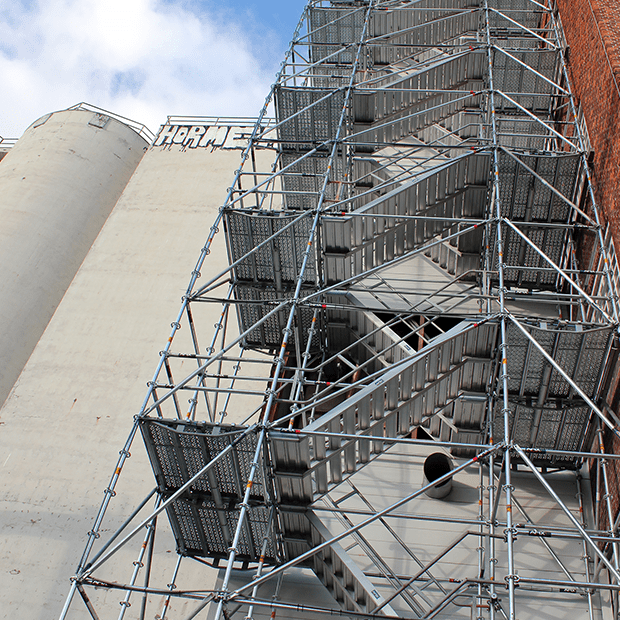Discover Leading Scaffolding Near Me for Your Home or Business Needs
Discover Leading Scaffolding Near Me for Your Home or Business Needs
Blog Article
Discovering the Different Kinds Of Scaffolding Utilized in Building Projects
The construction sector relies heavily on various sorts of scaffolding to satisfy certain task requirements, each offering distinct advantages and applications. Conventional framework scaffolding gives a durable structure for general jobs, while put on hold scaffolding is necessary for service high-rise frameworks. Other alternatives, such as system and rolling scaffolding, accommodate effectiveness and movement, respectively. Additionally, the cantilever alternative proves indispensable in metropolitan settings where area is constricted. Comprehending the subtleties of these scaffolding types is vital for maximizing safety and security and performance on building and construction websites, triggering a closer assessment of their distinct characteristics and applications.

Standard Structure Scaffolding
Standard framework scaffolding is just one of the most widely made use of approaches in the building sector because of its effectiveness and versatility. This system includes vertical and horizontal frameworks that are put together to produce a secure system for materials and workers. The major elements consist of vertical messages, horizontal journals, and diagonal braces, which with each other offer a strong framework that can sustain considerable loads.
Among the essential benefits of typical frame scaffolding is its flexibility to numerous building and construction projects, varying from property buildings to huge industrial frameworks. The modular layout enables simple setting up and disassembly, making it reliable for both lasting and short-term projects. Furthermore, the system can be tailored in height and width, fitting various structure designs and site conditions.
Safety and security is extremely important in scaffolding applications, and conventional framework systems are geared up with guardrails and toe boards to avoid drops and make certain employee security. In addition, normal examinations and adherence to safety policies are vital in keeping the honesty of the scaffold. On the whole, traditional frame scaffolding remains a fundamental choice in the construction sector, giving a reputable platform for labor and improving overall project efficiency

Suspended Scaffolding
Put on hold scaffolding uses an one-of-a-kind service for building and construction jobs that require access to raised surfaces, specifically in situations where conventional frame scaffolding might be impractical. This sort of scaffolding is typically put on hold from the roofing or top levels of a framework, utilizing a system of ropes, wheels, and systems to create a functioning space that can be adapted to numerous heights.
One of the key benefits of suspended scaffolding is its versatility. It can be conveniently repositioned or reduced to fit changes in building and construction needs, making it suitable for jobs such as home window installment, façade job, and upkeep on skyscrapers. Furthermore, the marginal impact of put on hold scaffolding allows for better use of ground area in urban atmospheres, where area is often limited.
Safety is a crucial factor to consider in the use of put on hold scaffolding. In general, put on hold scaffolding provides a reliable and reliable service for accessing hard-to-reach locations in numerous building and construction situations, improving both efficiency and security on site.
System Scaffolding
System scaffolding, frequently considered a modern-day remedy in the scaffolding sector, contains pre-engineered parts that can be swiftly put together and adjusted for different construction tasks. Scaffolding. This sort of scaffolding is characterized by its modular layout, which allows for convenience and effectiveness on task websites, accommodating structural requirements and different heights
Typically made from high-strength steel or light weight aluminum, system scaffolding advice provides enhanced longevity and stability. The parts include upright messages, straight ledgers, and angled dental braces, which interconnect safely, ensuring a durable framework. The layout commonly includes standardized fittings, simplifying assembly and disassembly procedures, thus lowering labor time and costs.

Rolling Scaffolding
Rolling scaffolding is a versatile choice to traditional set scaffolding, created for wheelchair and ease of usage on building and construction websites. This kind of scaffolding includes a platform supported by structures with wheels, enabling workers to quickly relocate it as required. The wheelchair feature significantly boosts performance, as it lessens downtime connected with taking apart and assembling dealt with scaffolding.
Commonly built from lightweight products such as aluminum or steel, rolling scaffolding provides a tough yet mobile option for jobs requiring regular repositioning - Scaffolding. It is particularly useful in tasks such as paint, drywall installment, and electrical job, where access to site numerous elevations and areas is required
Safety and security is critical in rolling scaffolding layout, with functions such as securing wheels to avoid unintended motion when being used, and guardrails to secure employees from falls. Additionally, lots of versions are adjustable in elevation, suiting various project demands.
Cantilever Scaffolding

The layout of cantilever scaffolding typically entails making use of arms or braces anchored to a structure or structure, enabling the system to extend outward securely. Security is paramount; hence, these scaffolds should be crafted to stand up to ecological conditions and different lots. Routine assessment and maintenance are important to make sure structural stability and worker safety and security.
Cantilever scaffolding is preferred for its flexibility and reliable use space, making it a preferred option in city environments where area constraints are usual. Furthermore, it assists in less complicated access find out to high altitudes, ultimately contributing to the total effectiveness of construction jobs. Just like all scaffolding types, correct training and adherence to safety and security requirements are critical for workers using cantilever scaffolding.
Final Thought
In verdict, the varied types of scaffolding used in building projects each serve distinct functions customized to certain website demands. Conventional framework scaffolding supplies security, while put on hold scaffolding offers adaptability for raised jobs. System scaffolding assists in fast setting up, and rolling scaffolding enhances movement for differing workplace. Cantilever scaffolding effectively attends to challenges in metropolitan setups. Understanding these scaffolding kinds is essential for optimizing safety and security and performance in building and construction, inevitably adding to the successful conclusion of projects.
Traditional structure scaffolding supplies a tough foundation for general jobs, while put on hold scaffolding is vital for job on skyscraper structures.Moving scaffolding is a flexible alternative to traditional set scaffolding, designed for movement and convenience of use on construction sites. As with all scaffolding types, appropriate training and adherence to safety criteria are important for employees using cantilever scaffolding.
Traditional framework scaffolding provides security, while suspended scaffolding offers adaptability for elevated tasks. System scaffolding promotes quick setting up, and rolling scaffolding improves flexibility for varying job environments.
Report this page